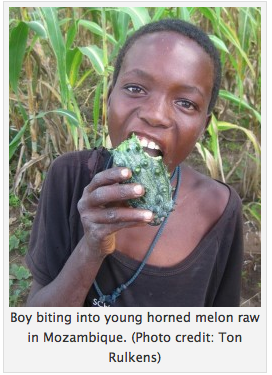Where most fruits lose their green color as they mature, the flesh of the African horned melon (Cucumis metuliferus) turns fluorescent green when ripe. And while the shelf life of most fruits is a few weeks at best with refrigeration, the horned melon can last six months without chilling, which actually shortens its shelf life by softening the fruit and making it more prone to molding. A bit of a horticultural oddity, the fruit is grown commercially in many places today but originates in Africa.

The plant grows wild from southern Africa to Nigeria and Ethiopia along roads, fallow land, and former crop land, but the color of wild fruit is not as bright as commercial cultivars. The plant is grown in home gardens in some places where the fruit is used like a cucumber in salads and young leaves are boiled and eaten like spinach. In Malawi, the fruit is commercially produced and sold in markets or eaten raw, made into relish, or pickled. In the Kalahari, wild fruits are baked whole over fire or peeled, halved, and then sun-dried to preserve them.
In 1982, a New Zealand couple began domesticating the plant, eventually commercially producing the fruit under the trade name Kiwano®. Today the fruit is produced commercially in Europe, Kenya, California, and Israel, where it is trademarked the Melano®. The texture of the fruit’s bright orange skin has been compared to a blowfish because of its sharp horns while the interior consists of pumpkin-like seeds arranged in a matrix of watery, fluorescent green jelly. To prevent injury during shipping and handling, the spiky horns of the fruit are rounded using a nylon brush.
In the U.S. and Europe, the flesh is eaten raw by halving the fruit lengthwise and scooping it out or by cutting off one end of the fruit and squeezing the inner jelly out after loosening it from the skin with a knife. The fruit is also used as a substitute for cucumber in salads, mixed with yogurt, made into ice cream or sorbet, and used as an ingredient in drinks or sauces. The fruit was an ingredient twice on The Food Network’s show Chopped, was a prop on an episode of Friends, and can even be purchased on Amazon. The plant is often used as an ornament since its appearance tends to be much more exciting than its flavor.
The fruit’s appearance and flavor draw mixed reactions, probably because there are so many different varieties. Some contain higher levels of the curcurbitacin toxin, for example, which contributes to a bitter flavor in the fruit. And, the fruit resembles a cucumber when young, but sweetens as it matures. This may explain why some find the fruit tasteless or unappealing while others compare its flavor to that of lime, banana, pomegranate, papaya, kiwifruit, other members of its cucurbit family such as cucumbers, or some combination of these.

Danielle Nierenberg, an expert on livestock and sustainability, currently serves as Project Director of State of World 2011 for the Worldwatch Institute, a Washington, DC-based environmental think tank. Her knowledge of factory farming and its global spread and sustainable agriculture has been cited widely in the New York Times Magazine, the International Herald Tribune, the Washington Post, and
other publications.
Danielle worked for two years as a Peace Corps volunteer in the Dominican Republic. She is currently traveling across Africa looking at innovations that are working to alleviate hunger and poverty and blogging everyday at Worldwatch Institute’s Nourishing the Planet. She has a regular column with the Mail & Guardian, the Kansas City Star, and the Huffington Post and her writing was been featured in newspapers across Africa including the Cape Town Argus, the Zambia Daily Mail, Coast Week (Kenya), and other African publications. She holds an M.S. in agriculture, food, and environment from Tufts University and a B.A. in environmental policy from Monmouth College.








